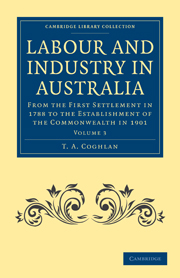 Labour and Industry in Australia
Labour and Industry in Australia Book contents
V - A VIGOROUS POLICY OF PUBLIC WORKS
Published online by Cambridge University Press: 07 October 2011
Summary
Australia commenced this period with a public debt of twenty-six and a half millions, and if to this be added thirty-three millions which had been invested in the country by private persons and monetary institutions, the total, fifty-nine and a half millions, represents the indebtedness of the country to its outside creditors. Of all the colonies Victoria was paying most attention to the development of its resources, but even in that colony the annual expenditure on public works did not exceed £460,000, of which about two-thirds were provided for out of loans.
In 1871 there was a plentiful lack of enterprise in all the colonies and a general acceptance of a policy of stagnation. There were of course exceptions to the general lethargy. Some politicians and a few newspapers demanded from the Governments a policy of progress, and now and then one or other of the Governments made a show of adopting such a policy, but there was a want of force behind any efforts that were made, and the old idea that Australia was a country of boundless possibilities seemed no longer to prevail. On 3rd June 1872 Sir Hercules Robinson arrived in Sydney to take up the duties of Governor of New South Wales. A week later the Parkes Government, which was then in office, announced a policy of railway extension, but it was one of those announcements, frequently made before, which would in ordinary circumstances drop out of mind when its purpose had been served.
- Type
- Chapter
- Information
- Labour and Industry in AustraliaFrom the First Settlement in 1788 to the Establishment of the Commonwealth in 1901, pp. 1405 - 1424Publisher: Cambridge University PressPrint publication year: 2011First published in: 1918
